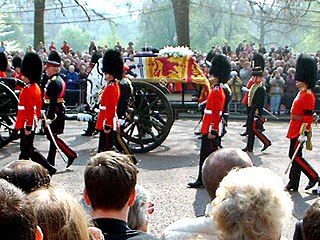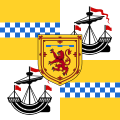Top Qs
Timeline
Chat
Perspective
Royal standard of the United Kingdom
Flags used by the British monarchy From Wikipedia, the free encyclopedia
Remove ads
The royal standard of the United Kingdom is the banner of arms of the monarch of the United Kingdom, currently Charles III. It consists of the monarch's coat of arms in flag form, and is made up of four quarters containing the arms of the former kingdoms of England, Ireland, and Scotland. There are two versions of the banner, one used in Scotland in which the Scottish quarters take precedence, and one used elsewhere in which the English quarters take precedence. Since the 1960s, personal flags for the monarch in their role as sovereign of other Commonwealth realms have been introduced.


The banner is flown to signify the presence of the monarch. It may be flown when they are present at one of their residences, from the car, ship, or aeroplane they are travelling in, and from any building they are visiting. The banner is never flown at half-mast, as a symbol of the continuity of the monarchy, since there is always a sovereign on the throne.[2]
Although almost universally called a standard, in heraldic terminology the flag is a banner of arms, as it is a coat of arms in flag form; standards are more typically tapering flags on which heraldic badges and mottoes are displayed.
Remove ads
United Kingdom (outside Scotland), the Crown dependencies, and the British Overseas Territories
Summarize
Perspective

In England, Northern Ireland, Wales, the Crown dependencies and the British Overseas Territories, the flag is divided into four quadrants. The first and fourth quadrants represent the ancient Kingdom of England and contain three gold lions (or "leopards"), passant guardant on a red field; the second quadrant represents the ancient Kingdom of Scotland and contains a red lion rampant on a gold field; the third quadrant represents the ancient Kingdom of Ireland and contains a version of the gold harp from the coat of arms of Ireland on a blue field. The inclusion of the harp remains an issue for some in Ireland. In 1937 Éamon de Valera, then Taoiseach, asked Dominions Secretary Malcolm MacDonald if the harp quarter could be removed from the Royal Standard on the grounds that the Irish people had not given their consent to the Irish emblem being included. The request was denied, and the harp remains.[3]

The modern Royal Standard of the United Kingdom, apart from minor changes (notably to the form of harp used to represent Ireland), dates to the reign of Queen Victoria. Earlier Royal Standards of the United Kingdom incorporated the Arms of Hanover and of the Kingdom of France, representing the title of Elector (later King) of Hanover and the theoretical claim to the throne of France, a claim dropped in 1800). The Hanoverian association terminated in 1837 with the accession of Queen Victoria who, being a female, could not accede to Hanover.
Famous Royal Standards of former British Monarchs include the Scotland Impaled Royal Standard of Queen Anne, the Hanover Quartered Royal Standards of King George I to George III, and the Hanover crowned Royal Standards of George III to William IV. The latter contained the Royal coat of arms of Hanover superimposed over what became the modern Royal Standard of the United Kingdom, although this particular standard's artistic representations of the banners of England, Ireland and Scotland in their respective quadrants was marginally different from the versions used today.
Remove ads
Scotland
Summarize
Perspective

Since 1998 (the year in which Scottish devolution legislation was enacted) a separate version of the Royal Standard of the United Kingdom has been used by the monarch in Scotland, whereby the red Lion Rampant of the Kingdom of Scotland appears in the first and fourth quadrants, displacing the three gold lions passant guardant of England, which occur only in the second quadrant.[4] The third quadrant, displaying the gold harp of Ireland, remains unaltered from that version used throughout the remainder of the United Kingdom and overseas. (Previously the same version of the standard was used throughout the United Kingdom).[5]

The Scottish version of the Royal Standard was used to cover the coffin of Queen Elizabeth II during the procession on the Royal Mile from the Palace of Holyroodhouse to St. Giles' Cathedral on 12 September 2022.[6]
Other members of the royal family also use this Scottish version when in Scotland (albeit the Duke of Rothesay has his own individual standard).[citation needed]
The Royal Standard of the United Kingdom used in Scotland differs from the Royal Standard of Scotland, which portrays the Lion Rampant in its entirety. As the banner of the Royal Coat of Arms of Scotland, the Royal Standard of Scotland remains a personal banner of the monarch [7] and, despite being commonly used as an unofficial second flag of Scotland, its use is restricted under an act passed in 1672 by the Parliament of Scotland.[8]
The historic Royal Standard of Scotland is used officially at Scottish royal residences, when the monarch is not in residence, and by representatives of the Crown, including the First Minister, Lord Lieutenants in their lieutenancies, the Lord High Commissioner to the General Assembly of the Church of Scotland, and Lord Lyon King of Arms. A variation of the Royal Standard of Scotland is used by the heir apparent to the King of Scots, the Duke of Rothesay, whose personal Royal Standard is the Royal Standard of Scotland defaced with an azure-coloured label of three points. (The banner of the Duke of Rothesay also features the same, displayed upon an inner shield).
Remove ads
Heir to the Throne
Summarize
Perspective
The direct heir to the Throne has several distinct standards and banners for use throughout the United Kingdom in representation of this position. William, Prince of Wales has five standards at use for his various roles and titles.
Historic
Remove ads
Other members of the royal family
Summarize
Perspective
Other members of the royal family have personal standards of their own. These are variants of the Royal Standard of the United Kingdom (including that which is used in Scotland), defaced with a white label and either three points or pendants (for children of a sovereign), or five points (grandchildren of a sovereign). Traditionally all princes and princesses of royal blood (i.e., descendants of the sovereign) are granted arms on their 18th birthday, thus giving them a banner to fly from their residences.
The following members of the royal family have personal standards, listed according to the line of succession:
Consorts of the British monarch
Queens consort of the British monarch are granted arms based on the Royal Standard and their own personal arms from before their marriage, or the arms of their family. In Scotland, a queen consort will use the Scottish version of the Royal Standard. They do not have different standards for the Commonwealth realms that have their own Royal Standards.
Consorts of a queen regnant are not granted use of the British Royal Standard. They use standards based on their own family arms. However, Prince Albert of Saxe-Coburg-Gotha used a standard of the royal arms (with a label for difference) quartered with his own family arms.
Recent historical royal standards
Royal standards of English and British monarchs, 1198–1837


Others



Other members of the royal family may use the Royal Standard of the United Kingdom, but within an ermine border (a white border with black "tails" representing the ermine fur). This standard is mainly used for the wives of British princes, or members of the royal family who have not yet been granted their own arms. Diana, Princess of Wales, and, Princess Alice, Duchess of Gloucester, had this standard draped over their coffins at their funerals.[17][18]
Camilla, Duchess of Cornwall, also enjoyed the right to use this version of the Royal Standard although she rarely exercised it on her own. She received a grant of arms on 17 July 2005, which, based on past practice, could form the basis for her own standard.[19] Since the ascension of her husband Charles III, as queen consort she has used a new version, based on her husband's royal standard, impaled with the arms of her father, Major Bruce Shand.[20]
Remove ads
Uses of Standards
Summarize
Perspective

The Royal Standard is reserved only for the monarch. Most famously it signals the presence of the monarch at a royal residence, and is also used on official vehicles, primarily the Bentley State Limousine, but also on other road vehicles at home or abroad, often a Range Rover. The Royal Standard is also flown from aircraft and water vessels, including HMY Britannia and MV Spirit of Chartwell[21] during the Thames Diamond Jubilee Pageant. When the monarch is aboard a British naval ship, the flag is flown from the main mast of the ship and is lowered upon his/her departure.[22] The flag is also draped over the coffin of the Monarch upon his/her death.

In some situations, personal standards are displayed within the UK, such as within St Giles' Cathedral, Edinburgh (site of the Chapel of the Order of the Thistle), and St George's Chapel, Windsor Castle home of Banners of Knights of the Order of the Garter,[24][25][26] at the Thames Diamond Jubilee Pageant Prince Andrew's standard flew from MV Havengore.[27] However, the use of personal standards of other members of the royal family varies in frequency. Prior to his accession, the then-Prince of Wales flew his standard at Clarence House in the same way the Royal Standard is used over Buckingham Palace, but other members of the family tend not to fly theirs from their respective residences (though this may be due to the fact that many share official London Residences, as is the case at Kensington Palace).

Family members also do not use their standards on road vehicles, either privately or during official engagements (when more discreet cars are used, such as Jaguar) or state occasions (when the Liveried cars of the Royal Mews are used), this seems reserved for the Queen only, although when Prince Philip traveled alone at state occasions, his standard flew from the roof of his car, as seen with the funerals of Diana, Princess of Wales (when the Queen Mother also flew her personal standard from her car) and that of Queen Elizabeth the Queen Mother, also, when a visiting Head of State on a state visit uses a car from the Royal Mews, his/her own flag is displayed.[28][29] That said, when abroad, the standards of members of the family may well be flown: examples include Prince Charles,[30][31] the Duchess of Cornwall[32] and Prince William.[33][34]
Personal Standards have been used to cover the coffins of the Queen Mother, the Prince Philip, Duke of Edinburgh, Princess Margaret[35][36] and the Duke of Windsor.
Position of Honour
According to the Flag Institute, the basic order of precedence for flags in the United Kingdom is – the Royal Standard, the Union Flag, the flag of the country, dependency or Overseas Territory of the United Kingdom (England, Scotland, Wales, etc.), other country, dependency or overseas territory flags of the United Kingdom, flags of other nations (in English alphabetical order), the Commonwealth Flag, the Flag of Europe, county flags, flags of cities and towns, banners of arms (personal and corporate), and house flags.[37]
Remove ads
See also
References
Further reading
External links
Wikiwand - on
Seamless Wikipedia browsing. On steroids.
Remove ads















































































